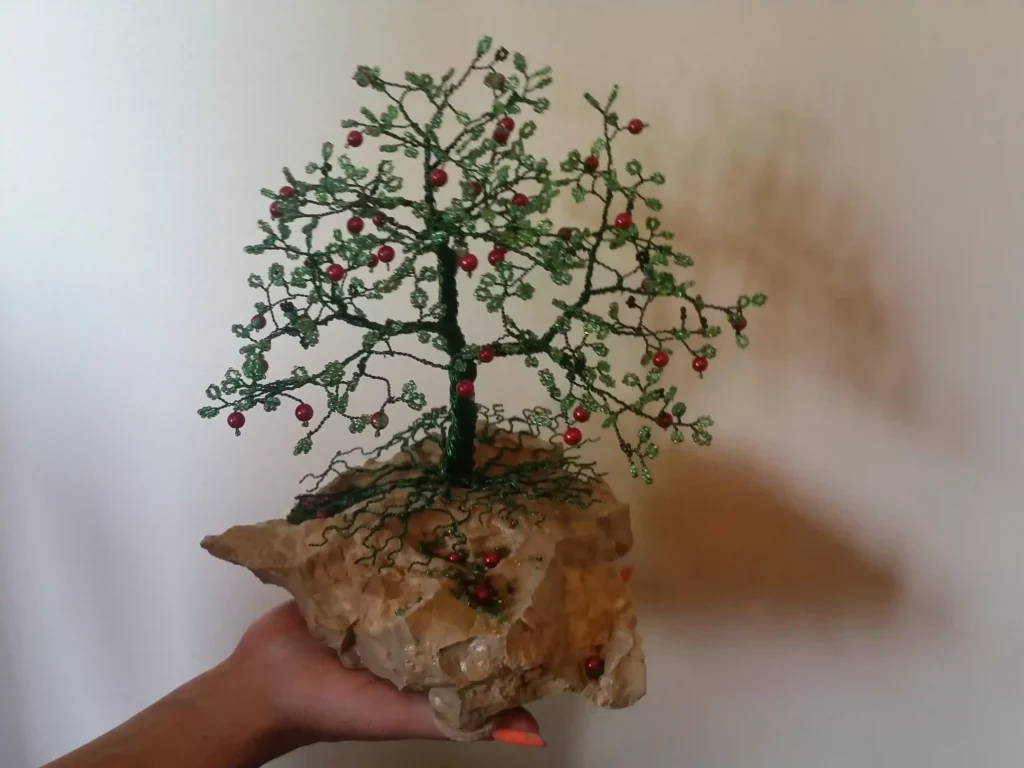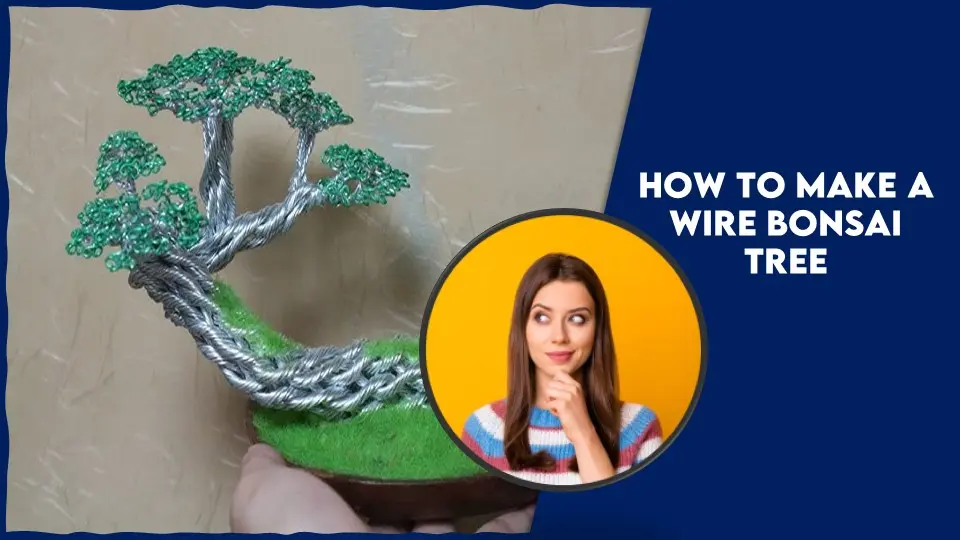How To Make A Wire Bonsai Tree – Craft With Us!
In the bonsai era, these stand out to be the master of arts and creativity. Wire bonsai trees are also a unique way of expressing your crafting fused with creativity. Wire bonsai trees will create enthusiasm among the people to sculpt various forms with the most precision added with imagination. The ability of wire bonsai to mold into different art forms and exceed the limitations set by live plants will allow every nature artist to blend each of these wires into a symbol of fineness that would result in stunning live entities.
But, how to make a bonsai wire tree metal sculpture? How to make a bonsai tree from wires? There are no constraints for this new aspect of creation because one need not be bothered about its age and growth. In this article, we shall know every detail about the hidden secret in crafting a wire bonsai in a step-by-step process. We shall find and explore all the possible ways of blending a wire into a beautiful sculpture.
The elegance of bonsai is not new to any of us. Join the bonsai journey with us and take part in creating miracles within your budget range. How to make a wire bonsai tree? How to make a wire bonsai tree sculpture? This article helps you with and lets you know how to make a wire bonsai tree and how to make a mini wire bonsai tree

How To Make A Wire Bonsai Tree Sculpture – Step By Step Guide
Gather Materials:
Wire – How to make a bonsai tree out of wire? Select high-quality bonsai wire in various gauges to accommodate different branches and trunk thicknesses. Aluminum or copper wire is commonly used for its flexibility and ease of manipulation.
Pliers – Choose a set of needle-nose pliers and wire cutters to bend and cut the wire with precision.
Base – Decide on a sturdy base for your wire bonsai tree, such as a small pot or wooden stand, to provide stability and support.
Foliage – Optional artificial foliage or preserved leaves can be added to enhance the realism of your wire bonsai tree.
Design Your Bonsai Tree
How to make a wire bonsai tree. Firstly, sketch a rough outline of your desired bonsai tree design, considering the overall shape, branch placement, and proportions. Determine the size and scale of your wire bonsai tree, keeping in mind the dimensions of your chosen base and the desired aesthetic.
Create the Trunk and Branches
Cut a length of wire for the trunk of your bonsai tree, bending it into a graceful curve to mimic the natural growth pattern of a tree. Use pliers to shape additional lengths of wire into branches, varying the thickness and direction to achieve a realistic and balanced appearance. Attach the branches to the trunk using smaller pieces of wire, securing them firmly in place while maintaining an organic flow.
Shape the Foliage
How to make a bonsai wire tree? Wrap thin wire around the branches to create a framework for the foliage, spacing the wire evenly to support the leaves or artificial foliage. Arrange the foliage around the wire framework, layering different textures and colors to mimic the intricate canopy of a real bonsai tree. Trim and adjust the foliage as needed, sculpting it into a harmonious composition that complements the overall design of your wire bonsai tree.
Refine and Detail
Use pliers to fine-tune the shape and position of the branches and foliage, paying attention to subtle nuances and asymmetry for a more naturalistic effect. Add details such as knots, twists, and bends to the wire to elevate the realism and character of your wire bonsai tree. Take breaks periodically to step back and assess your progress, making adjustments as necessary to achieve your desired aesthetic vision.
Secure the Bonsai Tree
How to make a wire bonsai has come to an end. Conceal any visible wires or attachments with moss, gravel, or other decorative elements to create a seamless transition between the bonsai tree and its base.
Anchor the wire bonsai tree securely to the chosen base using adhesive or wire, ensuring stability and preventing it from tipping or shifting.
How To Make A Beaded Wire Bonsai Tree

Materials needed
- Wire (preferably aluminum or copper, gauge depends on desired tree size)
- Beads (various sizes and colors for leaves and flowers)
- Wire cutters
- Pliers (round-nose and needle-nose)
- Base (pot, rock, or any stable object)
- Optional: Spray paint for the base, glue for securing the tree to the base
Prepare the Wire
Cut several lengths of wire, varying lengths depending on the desired size and shape of your tree. These will be the branches and trunk. Use thicker wire for the trunk and progressively thinner wire for the branches.
Create the Trunk
Take one of the thicker wires and bend it into a rough approximation of the trunk shape you want. This could be a straight trunk, or you might prefer a more twisted or gnarled look. Leave extra length at the bottom to anchor the tree to the base.
Form the Branches
Attach thinner wires to the trunk by wrapping them around and twisting them together. Gradually shape the branches by bending and twisting the wire until you achieve the desired look.
Add Beads for Leaves
Thread beads onto the thinner branches to represent leaves. Secure the beads by bending the wire slightly around them.
Optional (Add Flowers)
Thread beads of different colors onto the branches to represent flowers, if desired. These can be added sparingly for a subtle touch or more densely for a flowering bonsai look.
Form the Roots and Base
If you want your bonsai tree to appear as though it’s growing out of a rock or base, shape the wire at the bottom of the trunk into root-like structures. If using a separate base, secure the bottom of the trunk to the base using glue or by wrapping the wire around a protrusion on the base.
Final Adjustments
Once you’re satisfied with the overall shape and appearance of your beaded wire bonsai tree, make any final adjustments to the branches, leaves, and roots as needed.
Display
Place your finished beaded wire bonsai tree in a prominent location where it can be admired. You can also add decorative elements such as moss or small rocks around the base to enhance the overall aesthetic.
Types of Wire Used For Making Bonsai
How to make a copper wire bonsai tree? When making bonsai trees from wire, you’ll typically use annealed copper wire due to its flexibility, strength, and ease of manipulation. Annealed copper wire is copper wire that has been softened through a heating and cooling process, making it more pliable and easier to shape without breaking. How to make a bonsai tree from copper wire? Here’s the process.
Gauge
The gauge of the wire refers to its thickness. Thicker wire provides more support and is typically used for the trunk and primary branches, while thinner wire is used for finer details such as secondary branches and twigs. Common gauges used for making bonsai from a wire range from around 1.5mm to 6mm, depending on the size of the bonsai.
Annealed Copper
How to make a bonsai tree out of copper wire? Look for a wire that is specifically labeled as “annealed copper wire.” This type of wire has been treated to be more malleable and easier to work with. It retains its shape well once bent and is less likely to snap during manipulation.
Quality
Choose high-quality copper wire to ensure durability and longevity. Cheaper wires may be more prone to breaking or corroding over time, which can affect the stability and appearance of your bonsai tree.
Color
While copper wire is often chosen for its natural appearance, you can also find copper wire that has been coated or plated with different colors, such as green or brown, to blend in with the foliage of the bonsai tree. This can help create a more realistic and aesthetically pleasing look.
Availability
Copper wire for bonsai is widely available at gardening stores, bonsai nurseries, and online retailers specializing in bonsai supplies. Choose a supplier or dealer who offers a variety of gauges and lengths to suit your specific needs.
Precautions To Be Taken While Making Bonsai Tree From A Wire
When creating bonsai trees from wire, there are several precautions to consider to ensure the safety of both the artisan and the tree being sculpted. Here are some important precautions to take:
Use Proper Tools – Always use appropriate tools such as pliers and wire cutters designed for wire bonsai work. Usage of improper tools in an impromptu way can lead to accidents and injuries.
Wear Protective Gear – Wear safety glasses to protect your eyes from wire fragments or pieces that may fly off during cutting or manipulation. Apart from this, wearing gloves can also help you prevent cuts or abrasions that can happen while handling sharp wire edges.
Handle Wire Carefully – Be cautious when handling wire, especially when cutting or bending it. Sharp edges and ends can cause cuts or punctures if mishandled.
Mind Wire Thickness – Choose wire gauges suitable for the thickness and strength of the branches and trunk you are shaping. Using wire that is too thin may not provide enough support, while wire that is too thick may damage the tree.
Avoid Over-Bending – Be careful not to over-bend branches or trunk sections beyond their natural limits. Bending it beyond the limits it can hold can create stress to the tissue or can also lead to damage and sometimes result in death
Monitor Wire Placement – Regularly check wire placement to prevent it from cutting into the tree’s bark or branches as they grow. Adjust wire as needed to maintain proper alignment and avoid causing injury to the tree.
Mind The Tree Health – Work on healthy trees with strong, vigorous growth. Avoid wiring weak or sickly trees, as they may not tolerate the stress of wire manipulation and may suffer further decline.
Take Breaks – Wire bonsai work can be intricate and time-consuming, so take regular breaks to rest your hands and eyes. Doing it for longer periods repetitively can lead to fatigue of muscles and cause injuries
Work in a Well-Ventilated Area – If using adhesive or other chemicals to secure wire or foliage, ensure adequate ventilation to avoid inhaling fumes or vapors.
Educate Yourself – Before beginning any wire bonsai project, educate yourself on proper techniques and best practices through books, tutorials, or workshops. Learning from people who already have proven experience can help you avoid common pitfalls and achieve better results.
By following the above-mentioned steps and precautions, one can master the art of wire bonsai crafting which can also be enjoyed safely and responsibly that will aid in creating stunning miniature trees while ensuring the health and well-being of both yourself and your bonsai creations
Conclusion
Crafting a wire bonsai tree is a form of love that can be shown uniquely with artistic vision for which technical skill also definitely adds and this results in a breathtaking masterpiece that captivates the essence of nature in a unique and creative form. The careful and proper manipulation of wire and giving meticulous attention to every detail can help you customize bonsai tree designs in an easy manner which can also be infused with your charming personality and elegance.
Whether you’re drawn to the meditative practice of bonsai cultivation or simply inspired by the beauty of nature, creating a wire bonsai tree offers a rewarding and fulfilling creative outlet. All you need is a little patience, actually a lot of patience! and a good determination and dedication till the end to discover the boundless possibilities of wire bonsai craftsmanship. So, why not pick up your pliers and wire today, and let your creativity take root in the timeless art of bonsai sculpting? How to make a bonsai tree with wire. This will be perfectly answered and done by you if all steps are properly followed.

